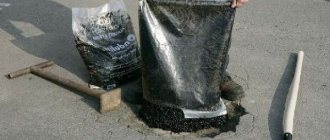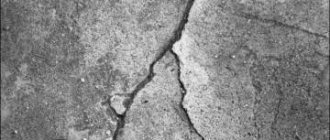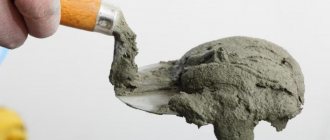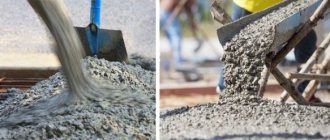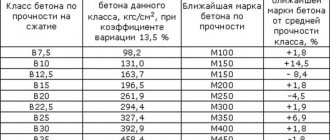What is asphalt? Asphalt composition
Asphalt is a finished road surface made from asphalt or asphalt concrete mixture. Asphalt or asphalt concrete mixture is a ready-made mixture of bitumen with mineral materials: crushed stone or gravel, sand (possibly with the addition of mineral powder). Asphalt is used for making road surfaces, for waterproofing, as a roofing material, and for making putties, adhesives, and varnishes. The highest quality asphalt is used in painting and in the creation of lithographs. Asphalt can be of natural and artificial origin: in natural mountain asphalt there is 60-75% bitumen, in artificial - 13-60%. Asphalt is often called asphalt concrete - an artificial stone material that is obtained by compacting asphalt concrete mixtures. Classic asphalt concrete consists of crushed stone, sand, mineral powder (filler) and bitumen binder (bitumen, polymer-bitumen binder; tar was previously used, which is not currently used).
Types and composition of asphalt
There are two types of asphalt used to cover roads: cold and hot. The composition of any type will be the same, the difference lies in the percentage of components.
The components of asphalt are:
The percentage of components depends on the road for which purpose the coating will be laid.
Asphalt concrete mixtures
Types of asphalt concrete mixtures produced by JSC "ABZ KAPOTNYA":
- COARSE-GRAINED – for the lower layers of two-layer asphalt concrete pavements.
- FINE-GRAIN – for the construction of main federal roads and streets with high traffic intensity.
- SAND – for pedestrian paths and sidewalks, car parking areas, retail areas.
- MIXTURES WITH POLYMER-BITUMEN BINDING - to increase the durability of coatings.
- MIXTURES WITH RUBBER-BITUMEN BINDING (BITREK).
- MIXTURES WITH UNIREM MODIFIER.
- RUBBER-ASPHALT CONCRETE MIXTURES – coatings of reduced rigidity, for example, for covering stadiums and running tracks.
- COLORED – paving areas of important government, administrative, cultural and educational institutions, park areas, etc.
- COLD STORAGE MIXTURES (COLD ASPHALT) – for pothole repair, transported over any distance in plastic bags.
- CAST - can be used for work in winter and pothole repairs, heated to high temperatures, and transported in special vehicles - kochers.
- CRUSHED STONE-MASTIC – durable and crack-resistant with a high content of fine crushed stone, especially strong.
- BLACK CRUSHED STONE – for foundation construction.
- WARM ASPHALT CONCRETE MIXTURES - for work at low temperatures.
Laying
Immediately after the material is delivered, asphalting occurs. If everything is done correctly, there will be a reliable coating for a long time, there will be no cracks.
There is also a special procedure for paving:
- 1) First, the asphalt is calculated (the area and cutting are measured);
- 2) Then the place for laying is prepared, the asphalt is dismantled and anchors are installed.
- 3) The area is cleared of moisture, dust and dirt (this is done thoroughly, otherwise it will affect the road, the coating will not stick and will begin to creep as a result);
- Primer . Bitumen and bitumen emulsion are suitable for it, they are also suitable for ordinary asphalt
- Laying . Large equipment is used if the area is more than 25 m^2. If it’s less, then workers lay out the asphalt manually, because using machinery is completely unprofitable.
- Seal . It begins immediately after the asphalt has been laid. To make the mixture dense, rollers or other static equipment are used. If the area is small, then use manual compaction.
In order for asphalt to have good quality, several factors and rules must be taken into account:
- stick only to proven and appropriate products; there must be a valid GOST (if the asphalt was delivered late and it is no longer what it should be, then it does not need to be laid);
- Thoroughly clean the surface on which the asphalt will be laid (without dirt, dust, moisture, or other chemicals, otherwise problems will begin later and the asphalt will crumble within a couple of months);
- it is also important to take into account the weather (if there is precipitation and it is cold, then work cannot be done, and in winter it is completely forbidden to lay asphalt).
By the way, read this article too: Solid fossil fuels
Compliance with the rules, taking into account the type of asphalt, is very important, because some types require a different temperature or operating time. Asphalt is sprinkled with cement to strengthen the road life and make the asphalt more durable.
Colored asphalt
JSC "ABZ KAPOTNYA" has mastered the production of colored asphalt. Colored asphalt concrete mixtures are used for landscaping squares, parks, squares, bicycle paths and other objects. We can offer our clients asphalt in red, pink, green, blue and gray colors. The following photographs show the laying of a gray asphalt concrete mixture in Kuzminki Park in August 2015.
Types of mixtures and their main parameters
First of all, all products of this type are divided into groups depending on which component is used as the main filler; there are gravel, crushed stone and sand mixtures.
Bitumen of different viscosities is also used, because of this the installation method may differ:
Working with hot asphalt requires special laying equipment; without it it is impossible to achieve a good result
- Warm asphalt concrete mixtures (many experts call them completely cold) can be laid at lower temperatures . The lower temperature limit is 5 degrees Celsius, but it is still better to carry out work at 20-30 degrees. Only liquid bitumen is used in production.
Kawabanga! How to fill holes in a concrete wall
Bitumen is the most important component, the quality of which largely determines the strength of asphalt
Worth remembering! The finished composition should be used for a maximum of 2-3 hours (depending on the brand). Otherwise, the bitumen will harden and it will become impossible to work.
Another important factor is the density of the asphalt concrete mixture.
You can also divide all compositions into fractions:
- If there are inclusions with a diameter of up to 40 mm - coarse-grained.
- For fragments up to 20 mm in size - fine-grained.
- If the size of the largest inclusions does not exceed 5 mm, it is sandy.
Depending on the amount of crushed stone present in the composition, the following types of asphalt concrete mixtures are distinguished:
Important! Crushed stone for the production of road mixtures must contain a certain percentage of flat (flaky) shaped fragments; the number of such fragments, depending on the brand of the composition, can range from 15 to 35%.
Cold asphalt
Cold asphalt (cold asphalt concrete mixture) is a ready-made material for patching asphalt concrete surfaces of roads, streets, sidewalks, sports and parking areas, courtyard areas, as well as filling holes after taking cores.
The main advantages of cold asphalt compared to traditional hot and cast mixtures:
- Possibility of harvesting for future use and long-term storage (up to one year);
- Can be used at any time of the year (at temperatures from -10 C to 40 C) and in any quantity (from 1 package to several tons);
- Unlimited transportation range;
- Environmentally friendly when used;
The use of cold asphalt allows the consumer to:
- Save energy and labor costs when carrying out repair work (1-2 people are enough);
- To simplify the technology for carrying out repair work as much as possible - just clean the bottom and walls of the pothole from debris and debris, pour out the required amount of mixture and tamp (compact) with any available means (a shovel, a car wheel, a vibrating plate, a light roller);
- Significantly reduce the time and costs of repair work;
- Open traffic immediately, without restrictions, after the completion of pothole repairs.
Brief recommendations for the use of cold asphalt
- Cold asphalt is used at any time of the year to quickly eliminate minor damage to road asphalt concrete pavements in order to prevent them from developing into larger ones and restore the required performance properties of the pavements.
- Cold asphalt is recommended for use when repairing potholes up to 1.5 m2 in size and 3-4 cm deep or more.
- Before using cold asphalt (cold mix), it is necessary to clean the bottom and sides of the pothole from dirt, debris, snow and ice.
- To repair 1 m2 of coating with a destruction depth of 5 cm, about 80 kg of mixture is required.
- The cold mixture is supplied to the consumer in bags (30-40 kg) or in plastic buckets (20-25 kg). To fill a pothole, just open the bag (bucket lid) and pour out the mixture in the required amount, level it and roll it (you can use a car wheel, a vibrating plate or other means).
- The thickness of the laid cold mixture (not compacted) should exceed the thickness of the coating by 2-2.5 cm (margin for compaction).
- When patching during subzero temperatures, the container with the cold mixture is stored in a warm room to preserve its workability and compactability.
- It is advisable to use a cold mixture at an ambient temperature not lower than -10 - -15C.
- After completion of pothole repairs, vehicle traffic can be fully restored without any restrictions.
Technology and manufacturing process
The manufacturing technology is not simple. The location of the asphalt plant plays an important role. First, the starting elements are mixed at high temperature. They are stored in bunkers, and then the asphalt is sent to the desired installation site. To ensure that the coating does not lose strength, the material must not be hard. It is because of this that factories are chosen closer to the place of work.
Let's highlight several stages:
- 1) Prepare the elements. First, crushed stone, sand, and mineral materials are dried at high temperatures to remove moisture.
- The crushed stone is sieved, the elements are separated, and then distributed into tanks for the production of other asphalts. Mineral materials are distributed using a crusher, so they turn out like dust, then fragmentation occurs. Sifting and drying can occur in different ways, it all depends on the technology and the desired result
- 2)Mix the elements. First, sand and crushed stone are mixed onto the conveyor in the required proportions. Butim is added after obtaining a homogeneous mass. In this case, the temperature should be approximately 160 degrees. So the mixture remains in the bunker for no more than 4 days, during which time it is delivered to the desired place; if you do not have time, it will harden and cannot be used. Next, workers must check the correct composition.
By the way, read this article too: Oil grades (grades)
At the mixing stage, mineral elements and various additives are added. Rubber crumbs are added inside the entire composition when making a rubber-asphalt mixture.
Delivery takes place using cars. Dump trucks are well suited for this; they are capable of transporting heated trains. But they are only for short distances; for long distances, special kochers and cars with heat resistance are suitable. In such machines, asphalt can be stored while maintaining the required temperature for up to 2 days.
Compound
Artificial asphalt can be crushed stone, sand or gravel, depending on the name of the aggregate used. The latter can be coarse-grained or fine-grained - the choice depends on the tasks at hand. For coatings that are resistant to high loads, coarse crushed stone is needed; for a perfectly smooth surface, fine-grained asphalt is suitable. Asphalt concrete is also distinguished by density - dense and porous samples are produced. Another factor is the condition of the binder; it can be hot or cold.
The main ingredients of asphalt concrete are:
- bitumen - from 2.5 to 20%;
- stone aggregate (crushed stone or gravel) - most of the mixtures are used with their inclusion, but there are varieties without it;
- mineral powders;
- modifying components that improve the adhesion parameters of the coating with tires, sound insulation, etc.
There are types of asphalt concrete that contain crumb rubber. It is characterized by high cost and improved performance properties.
